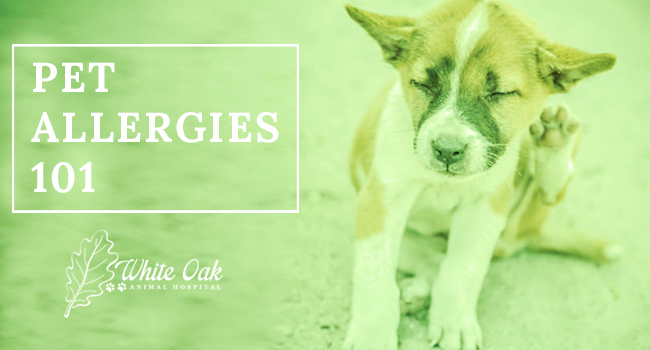
Whether human or pet, allergies usually prove to be a complicated, and sometimes frustrating, topic. The good news – it’s not always a dead end diagnosis. Though sometimes a timely process, there are treatments for most allergy symptoms.
It is important to understand pet allergies is a broad category consisting of many sub-categories. Every allergic reaction is different, and they all have different treatments. However, symptoms do not discriminate, making treatment difficult for the veterinarian, client and patient.
Some allergy symptoms include:
- Red, inflamed skin
- Moist OR scabbed/scaly skin
- Scratching
- Chewing feet
- Chewing base of tail/back
- Itchy, watery eyes
- Excessive licking
- Alopecia (hair loss)
- Sneezing
- Vomiting
- Diarrhea
- Chronic ear problems.
Once you recognize the symptoms, then it is time to pinpoint the cause. This is where the ‘sub-categories’ come into play.
The four major categories of allergies include:
- Flea
- Food
- Contact
- Atopy.
Flea Allergies
Flea allergies, often referred to as flea allergy dermatitis (FAD), is exactly as it sounds. A pet with FAD can go into an itching rage with as little as one flea bite. The best treatment for this type of allergy is as simple as keeping your pet on a flea preventative YEAR ROUND.
As for the damage already done, your regular veterinarian can usually give Fluffy some relief with a short course of steroids and/or antibiotics. These are typically used to treat the secondary skin infection that comes along with FAD, due to your pet’s constant licking and scratching.
Food Allergies
Most would not think about animals having an allergy to food. Nevertheless, around 10% of pet allergies are food related. The ingredients that trigger this allergy in pets can range from chicken to corn to the grains included in the diet.
The most common method used to diagnosis this allergy is a very strict food elimination trial. The pet will be placed on a hypoallergenic diet and/or a very specific home cooked diet for several months. Eventually, different foods are introduced, one at a time, to determine which ingredient triggers an allergic reaction.
Contact Allergies
Some pets can have an allergy to things they may come in contact with in their everyday environment. This can range from shampoos, dust mites to certain types of plastics (such as the plastics used to make a water bowl). The possibilities are endless. Treatment will depend on the trigger of the allergy. Sometimes it can be as simple as removing the cause.
Atopy
Lastly, we’ll discuss atopy (also referred to as inhalant allergies). As humans, this is probably the one type we can relate to the most. Trees, pollen, mold and cigarette smoke are a few of the many causes of this type of allergy. Taking into consideration all of the possible triggers, these allergies can be hard to pinpoint. However, treatment is available.
When treating atopy, typically you want to start out with baby steps. First, you start with an antihistamine, such as diphenhydramine. If there is no response, corticosteroids are the next step. Steroids can be a frightening word for some people. The truth is, anything in excess can be a bad thing. When used in moderation, steroids are very safe and often a saving grace in the case of allergies.
Additional Treatment Options
Tried antihistamines and steroids and neither worked for your pet? Immunosuppressive medications are the next option. This type of medication stops the body’s natural inflammatory response when the pet is exposed. Cyclosporine is a common immunosuppressant drug in the veterinary world.
Typically, owners elect to treat the symptoms of atopy with pharmaceuticals as they arise. After all, there is no way to eradicate the things that naturally occur in this world. However, if you and your pet have been through all of the above treatments and still haven’t achieved your goal, allergy testing may be recommended. Testing allows the veterinarian to pinpoint the exact trigger of your pet’s allergies. Immunotherapy usually follows allergy testing. This type of therapy, as in humans, involves repeatedly introducing the body to the specific antigen(s) causing problems. In turn, the body should build up immunity to the antigen.
It’s important to remember it is not uncommon for an animal to suffer from multiple allergies. In which case, you would need to treat each independently. For example, an animal may have a food allergy to chicken and be allergic to pollen. So, this animal may be banned from chicken and treated with antihistamines when needed.
Every animal and every case is different!
Powerful Tools for Overcoming Dog Allergy Challenges
There are many quick and easy changes you can make at home to help you give your dog an edge on easing allergy challenges.
- Learn more about dog allergies.
- Learn more about cat allergies.
- Switch to a Limited Ingredient Diet. PET | TAO’s Limited Ingredient Diet is naturally low in foods that stimulate an allergic response.
- Supplement with medicinal mushrooms. PET | TAO’s Complement Immune Mushroom Blend eases inflammatory response and ease symptoms.
- Try digestive enzymes and probiotics. PET | TAO’s Harmonize Gi boosts gut health and combats food allergens.
- Feed PET | TAO’s Freeze Dried Lung Treats. According to TCVM, Lung is on the same meridian as the skin. Therefore, lung treats help both breathing and skin allergies. Lung treats support lung and skin similar to a glandular supplement in a “like treats like” fashion.
- Learn more about TCVM Herbal Remedies. Chinese medicine offers many amazing natural solutions for dog allergies Some good examples are:
Powerful Tools for Overcoming Cat Allergy Challenges
There are many quick and easy changes you can make at home to help you give your cat an edge on easing allergy challenges.
- Learn more about cat allergies.
- Switch to a Limited Ingredient Cat Food Recipe. PET | TAO’s Limited Ingredient Cat Food Recipe is naturally low in foods that stimulate an allergic response.
- Supplement with medicinal mushrooms. PET | TAO’s Complement Immune Mushroom Blend eases inflammatory response and ease symptoms.
- Try digestive enzymes and probiotics. PET | TAO’s Harmonize Gi boosts gut health and combats food allergens.
- Feed PET| TAO’s Freeze Dried Lung Treats. According to TCVM, Lung is on the same meridian as the skin. Therefore, lung treats help both breathing and skin allergies. Lung treats support lung and skin similar to a glandular supplement in a “like treats like” fashion.
- Learn more about TCVM Herbal Remedies. Chinese medicine offers many amazing natural solutions for dog allergies Some good examples are:
Related Posts
-
When Should I Spay or Neuter My Pet?
Should I Spay or Neuter My Pet? For many years, veterinarians recommended clients spay or…
-
The Best Way to Get Rid of Cat Allergies Naturally
Would You Like to Know How to Get Rid of Cat Allergies Naturally? Like people,…
-
Managing Pet Dental Needs at Home
Looking for ways to manage your pet dental care needs at home? While we…
-
Are Dental Cleanings for Pets Necessary?
I can usually count on it at least once a week. I follow the…









